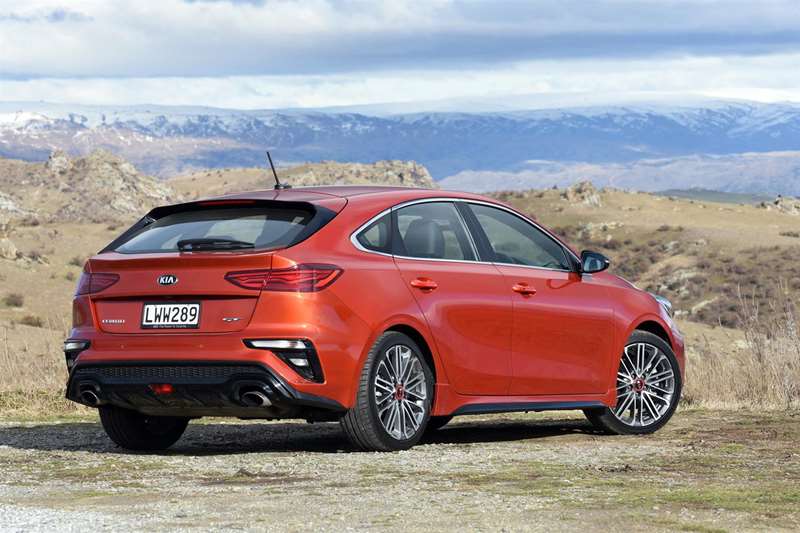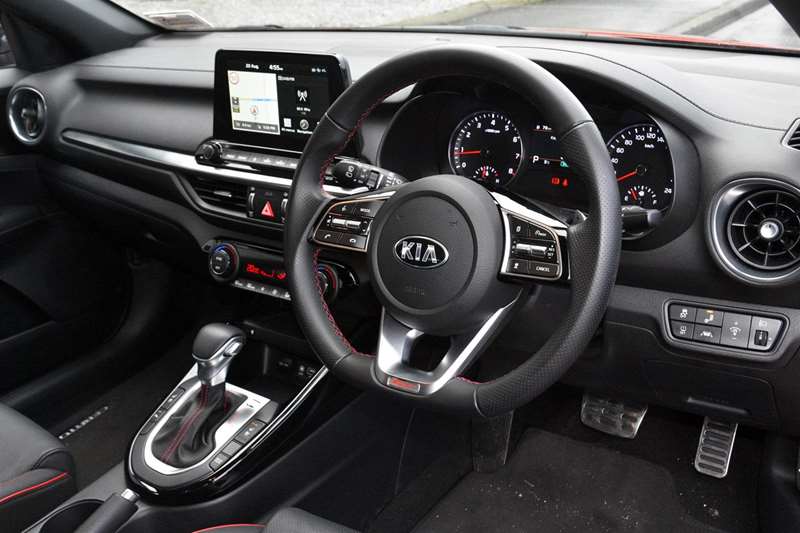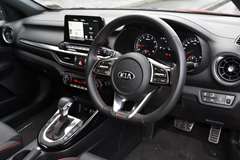Having driven the impressive Cerato GT Line earlier in the year, David Thomson jumped at the chance to get behind the wheel of the higher spec GT model.
What’s new?
The fourth-generation Kia Cerato has been on sale for several months, and it’s already been put through its paces by Drivesouth in mid-range GT Line guise. Now it’s the turn of the flagship model — the pure GT — to make an appearance.
By way of a quick refresh, the range comprises sedan and hatchback options in LX and EX forms, and the hatchback-only GT-Line and GT. The mainstay engine is a 112kW/192Nm non-turbo 2.0-litre that carries over from the previous Cerato, but the flagship GT features a more potent 1.6-litre turbo powerplant.
Producing peak outputs of 150kW and 265Nm, it is paired with a seven-speed dual-clutch automated manual transmission. As well as delivering greater performance, the flagship engine is more economical, managing a 6.8-litre per 100km standard cycle economy return compared to a 7.4l/100km result for the 2.0-litre mill.
What comes as standard?
Like the $39,990 GT Line, the $41,990 GT features LED head and tail lights, heated and ventilated front seats (power-operated), climate control air-conditioning and wireless phone charging. Its eight-inch centre touchscreen is home to satellite navigation, a reversing camera, sound system, Apple CarPlay and Android Auto smartphone integration. The safety specification,
meanwhile, includes a range of active features such as radar cruise control, autonomous emergency braking, lane keeping assistance, blind spot detection, rear cross traffic alert and driver alert assist.
Along with the more potent drivetrain, the GT’s price premium secures 18-inch rather than 17-inch alloy wheels, upgraded brakes, and an eight-speaker sound system.
What’s it like to look at?
The sleek lines of the Cerato hatch are nicely emphasised on the GT Line, but have an extra sporting edge on the GT. Those larger wheels (10-spoked rather than five) and correspondingly lower-profile tyres play a key role in achieving this look, augmented by changes to the exterior trimmings, including a dual exhaust.
What’s it like inside?
Opting for the sportiest model in the Cerato range doesn’t entail any sacrifices in terms of space. Along with a roomy cabin, albeit a little enclosed in the back, boot space is a decent 428 litres.
The embossed front seats with their contrast stitching are supportive and the space between them is well set-out, with a deep centre bin and USB charging points. The cubby area is forward of the gearshift. The dash and centre console are also neatly executed, with a particular focus on minimising clutter, complemented by the sporting emphasis of the GT-badged sports
steering wheel.
What’s it like to drive?
The GT Line proved a very comfortable car. However, there was some disappointment at a relative lack of sporting vim, manifested via the quite modest performance abilities of its 2.0-litre engine, and limited dynamic agility and feel.
As anticipated, the combination of a more powerful and responsive engine, superior transmission, improved brakes and a more overtly sporting suspension set-up — complete with a multi-link rear — give the GT a quite different feel.
A Drive Mode button to the left of the gear shift enables switching between the Eco, Comfort and Smart modes, but Sport mode is needed to explore the Cerato GT to the full. This is engaged via the gear shift, though the serious business of overriding the transmission’s own decision-making once in Sport mode is best accomplished by using the paddle shifts that are tucked behind the spokes of the steering wheel.
Assessed over an extended return drive from Dunedin to Cromwell, the GT impressed through the twists and turns to a far greater degree that the GT Line.
Unsurprisingly given its 28% power and 38% torque advantage, the 1.6-litre engine packs a lot more punch than the 2.0-litre. While at its best quite high in the rev range, there is decent pull from 2000rpm, and it really starts to build beyond 3000rpm. As a result, the engine is highly responsive when cruising as well as when hustled along.
Front-end grip is impressive even under hard cornering, while the multi-link rear suspension plays a vital role in delivering greater agility and better handling. Add in good steering feel and brakes, and all the ingredients deliver plenty for the keen driver in fine conditions.
Rain, which was a constant companion on the run home, brings the need for a more cautious approach. Even so, the test car continued to be plenty of fun in damp and sometimes soaking conditions.
Improved handing comes at some cost in terms of refinement: ride quality is firm, impacting more on around-town than open-road comfort, and the low-profile Michelin Pilot tyres transmit a fair amount of coarse-chip road rumble into the cabin at highway speeds.
Verdict
If you are after an all-round option with elements of sporting flair, then the GT Line may well be the best option in the new Cerato line. However, the pure GT is much more rewarding and convincing as a performance machine, especially when it takes only a modest $2000 price premium to secure substantially enhanced sporting potential.
Photos: David Thomson












